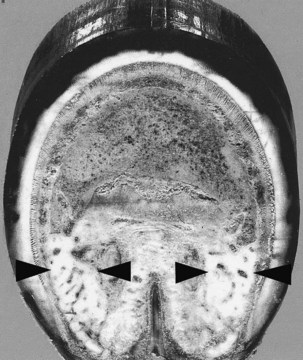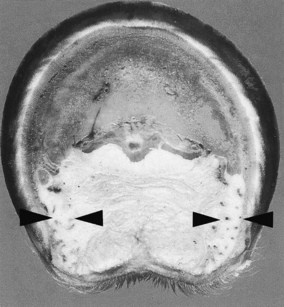Chapter 29 Functional Anatomy of the Palmar Aspect of the Foot
The cartilages of the foot lie beneath the skin and dermis and the coronary venous plexus and have previously been described as rhomboid-shaped, with a convex surface abaxially and a concave surface axially. Several ligaments secure the cartilages of the foot to the digital bones.1-4 However, these descriptions are overly simplistic and appear to have been obtained from examination of horses with underdeveloped structures of the palmar aspect of the foot. The morphological features of the cartilages of the foot vary greatly, with a range of shapes and thickness, the presence of an axial projection from its distal edge, and the extent of vascularity.5 The structure of the cartilages of the foot is best determined by viewing the foot in transverse sections (Figures 29-1 and 29-2). In frontal (dorsal) sections cut perpendicular to the ground, beginning at the bulbs of the heel, the cartilages of the foot have a C– to L-shaped configuration. Both the upright and the base parts of the L-shaped cartilage vary in thickness among horses. The mean thickness of the upright part at the level of the navicular bone ranges from 0.5 to 2.0 cm in an adult horse (450 to 550 kg body weight). The base part or axial projection of the L-shaped cartilage varies in its thickness and the distance that it extends toward the midline of the foot overlying the bars and the frog. The cartilages of the foot are thinnest in the heel region (0.45 to 1.3 cm) but become thicker closer to the distal phalanx (0.6 to 1.5 cm) and thin slightly as they attach onto the distal phalanx (0.5 to 1.0 cm). The cartilages of the foot are thicker in forelimbs than hindlimbs.
Stay updated, free articles. Join our Telegram channel

Full access? Get Clinical Tree




